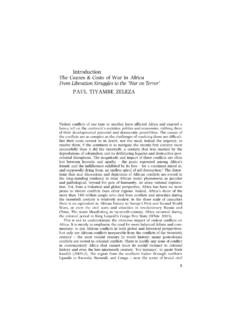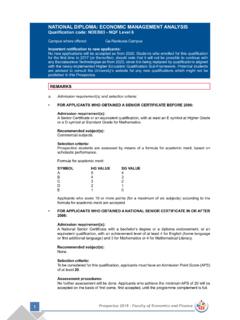Transcription of A History of Conflict and International Intervention in Libya
1 Global Security Studies, Winter 2015, Volume 6, Issue 1. A History of Conflict and International Intervention in Libya Ryan Timothy Jacobs Department of International Affairs University of North Carolina, Wilmington 601 South College Road, Wilmington, NC 28403. Abstract The purpose of this research is to examine the Conflict in Libya ; most notably from the 2011. ousting of Colonel Muammar Gaddafi up to the present issues surrounding the state. Centralizing on the overall political and economic History of the African state, the following will elaborate upon the socio-dynamics within Libyan borders; and provide explanations for present day conditions.
2 Utilizing a comparative analysis of other African states which have been presented with similar issues serves in determining the criteria that International actors can examine to identify management and resolution skills that meet issues in present day Libya . Keywords: Libya , Intervention , Gaddafi, United Nations, Conflict Management and Resolution, United States, European Union, Libyan Arab Jamahiriya, NATO, African Union. Introduction The state of Libya has had a long History of struggle. As far back as the 7th century , the inhabitants of the now 679,358 square mile region of Africa have regularly been in intrastate conflicts , under the rule of various empires such as the Roman Empire from 46 to 436 and the Ottoman Empire in the 16th century , riddled with Barbary pirates raiding merchant ships, had hostilities with large nation-states including Italy, and was home to much of the desert fighting during the World War II.
3 The political infrastructure was also highly influenced by the Italian Imperialism during the First World War; and with Italian interests in African territory, the fascist ideology which spread throughout the region also impacted Libyan governance during this time. This included the establishment of concentration camps to prevent resistance. The overwhelming arrival of foreigners gave rise to a divided society which also continues to cause Conflict in the region. Yet, as fascism crumbled during the war, Libya had an opportunity to rid themselves of Italian oppression. At this time, as natural enemies of Italy due to their imperialistic rule, Libya joined forces with the and Great Britain to drive Italians, as well as Germans out of this particular region of North Africa.
4 It was not until after World War II (in 1951) that the region became the United Kingdom of Libya , and was recognized as an independent sovereign state. In the 1950s, it is also agreed that the future of Libya will be referred to the United Nations. In addition, it was in the 1950s that the United Kingdom of Libya held their first election and Mohammed Idris became king. For the first eight years as king, Idris did not do much to improve the economic, political or society of Libya . Although, shortly thereafter, oil was discovered, which assisted in the growth of Libya 's economy. This discovery assisted Libya in securing the withdrawal of foreign troops, and the need for British and airbases and International aid.
5 1. History of Conflict and International Intervention in Libya In the bloodless coup of 1969, Mohammed Idris was overthrown and Moamar al-Gaddafi became commander in chief of the armed forces, and the chairman of the Revolutionary Command Council. Gaddafi quickly gained a reputation as being both unpredictable and aberrant. His political philosophies, a 1977 unveiling of the once named United Kingdom of Libya to the "People's Socialist Libyan Arab Jamahiriya", caused tension in relationships with neighboring states, the funding of terrorists groups, and assassination squads to silence Libyan enemies during the late 70's and early 80's got the attention of the ; and in 1986 President Ronald Reagan demonstrated commitment to International anti-terrorism activity by performing an air strike over Benghazi and Tripoli, Libya .
6 More specifically, during this time and up to more recent years, Gaddafi used oil revenues to promote his ideology outside Libya , supporting subversive and terrorist activities that included the downing of two airliners - one over Scotland, another in Northern Africa - and a discotheque bombing in Berlin. UN sanctions in 1992 isolated Gaddafi politically and economically following the attacks. Sanctions were also lifted in 2003 following Libyan acceptance of responsibility for the bombings and agreement to claimant compensation. Gaddafi also agreed to end Libya 's program to develop weapons of mass destruction, and he made significant strides in normalizing relations with Western nations.
7 Unrest that began in several Middle Eastern and North African countries in late 2010 erupted in Libyan cities in early 2011. Gaddafi's brutal crackdown on protesters spawned a civil war that triggered UN authorization of air and naval Intervention by the International community. After months of seesaw fighting between government and opposition forces, the Gaddafi regime was toppled in mid-2011 and replaced by a transitional government. In February of 2011, a revolution began in Libya . After forty two years in power, Colonel Mummar Gaddafi's regime was being threatened to be dismantled in retaliation for what rebel forces, ordinary citizens, and International organizations deemed inhumane acts.
8 As pressure mounted, although reluctant because of the revolts in neighboring states (Tunisia and Egypt), and the financial and political toll of the prior interventions in Iraq, and Afghanistan; Great Britain and France pressured the to take action in Libya . In March of 2011, backed with the support of the Arab League, the decided to push the UN for a resolution that allowed military action in Libya to protect civilians. UN Security Council Resolution 1973 was passed and allowed for the establishment of a no-fly zone, a group of officials to manage political Intervention , support of rebel forces in Libya , which were all aimed at putting pressure on the colonel, and the Libyan Arab Jamahiriya to step down.
9 Christopher S. Chivvis, a senior political scientist for the RAND Corporation details the Intervention as a high-tech, combined, joint mission operating from Europe, the United States, and elsewhere in the Middle East and North Africa. Military operations relied heavily on presision airpower, striking some 6,000 targets, mostly along Libya 's Mediterranean coast. All told, the operation would draw on more than 8,000 personnel, 21 warships, and some 250 aircraft flying more than 26,000 There were 19 countries that were involved in the Intervention , providing military assistance and support for the capture and ultimately the death of Gaddafi.
10 1. Chivvis, Christopher S. Toppling Qaddafi: Libya and the Future of Liberal Intervention . New York: Cambridge University Press, 2014. 2. Jacobs In 2012, Libya formed a new parliament and elected a new prime At the end of the civil war, militias continued to clash over political differences. The various problems that have arisen post Libyan Civil War (or the Libyan Revolution), including the September 11, 2012. attack on the diplomatic mission in Benghazi escalated into the current 2014 Libyan Conflict . Causes of Negative Conflict in Libya Edward Newman argues that one of the most notable reasons behind interstate Conflict in states such as Libya is the society's colonial past.








